A) shift curve A to the right and shift curve B upward.
B) shift curve A to the left and shift curve B downward.
C) leave curve A in place but shift curve B downward.
D) leave curve A in place but shift curve B upward.
Correct Answer

verified
Correct Answer
verified
Multiple Choice
Suppose that a mixed open economy is producing at its equilibrium income and that net exports are zero. If at the equilibrium income the public sector's budget shows a surplus,
A)
B) planned investment must exceed saving.
C) a recessionary expenditure gap must exist.
D) saving must exceed planned investment.
Correct Answer

verified
Correct Answer
verified
Multiple Choice
Other things equal, if $100 billion of government purchases (G) is added to private spending (C + Ig + Xn) , GDP will
A) increase by $100 billion.
B) increase by less than $100 billion.
C) increase by more than $100 billion.
D) fall by $100 billion.
Correct Answer

verified
Correct Answer
verified
Multiple Choice
The table gives data for a private closed economy. The MPS is
A) 7/10.
B) 3/10.
C) 2/5.
D) 3/5.
Correct Answer

verified
Correct Answer
verified
Multiple Choice
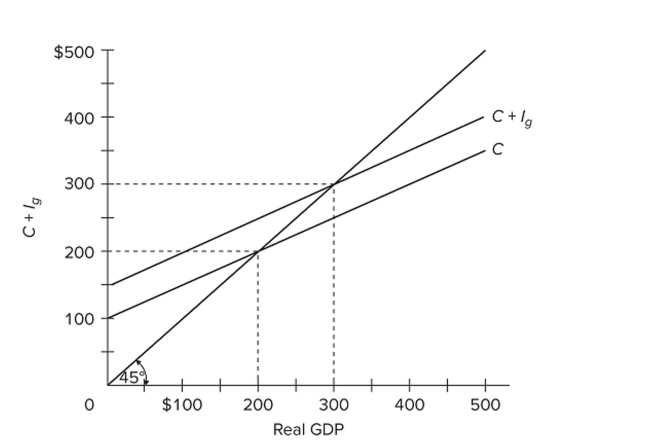 Refer to the diagram for a private closed economy. The MPC and MPS are
Refer to the diagram for a private closed economy. The MPC and MPS are
A) 0.6 and 0.4, respectively.
B) 0.7 and 0.3, respectively.
C) both 0.5.
D) both 0.7.
Correct Answer

verified
Correct Answer
verified
Multiple Choice
Suppose that the level of GDP increased by $100 billion in a private closed economy where the marginal propensity to consume is 0.5. Aggregate expenditures must have increased by
A) $100 billion.
B) $50 billion.
C) $500 billion.
D) $5 billion.
Correct Answer

verified
Correct Answer
verified
Multiple Choice
A $1 increase in government spending on goods and services will have a greater impact on the equilibrium GDP than will a $1 decline in taxes because
A) government spending is more employment intensive than is either consumption or investment spending.
B) government spending increases the money supply and a tax reduction does not.
C) a portion of a tax cut will be saved.
D) taxes vary directly with income.
Correct Answer

verified
Correct Answer
verified
Multiple Choice
The aggregate expenditures model is built upon which of the following assumptions?
A) Prices are fixed.
B) The economy is at full employment.
C) Prices are fully flexible.
D) Government spending policy has no ability to affect the level of output.
Correct Answer

verified
Correct Answer
verified
Multiple Choice
(Advanced analysis) The equations give information for a private open economy. The letters , and stand for GDP, consumption, gross investment, exports, and imports, respectively. Figures are in billions of dollars. International trade in this case
A) has an expansionary effect on GDP.
B) has a contractionary effect on GDP.
C) has no effect on GDP.
D) is causing in?ation in this economy.
Correct Answer

verified
Correct Answer
verified
Multiple Choice
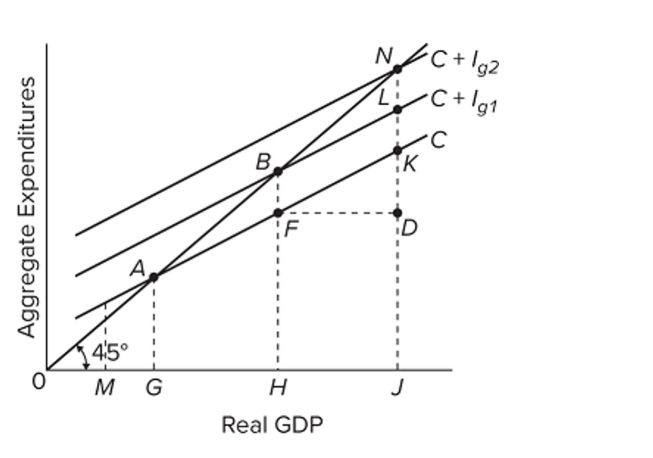 Refer to the diagram, which applies to a private closed economy. If gross investment is Ig1, the equilibrium GDP and the level of consumption will be
Refer to the diagram, which applies to a private closed economy. If gross investment is Ig1, the equilibrium GDP and the level of consumption will be
A) H and HB, respectively.
B) J and JI, respectively.
C) J and JK, respectively.
D) H and HF, respectively.
Correct Answer

verified
Correct Answer
verified
Multiple Choice
The level of aggregate expenditures in the private closed economy is determined by the
A) expenditures of consumers and businesses.
B) intersection of the saving schedule and the 45-degree line.
C) equality of the MPC and MPS.
D) intersection of the saving and consumption schedules.
Correct Answer

verified
Correct Answer
verified
Multiple Choice
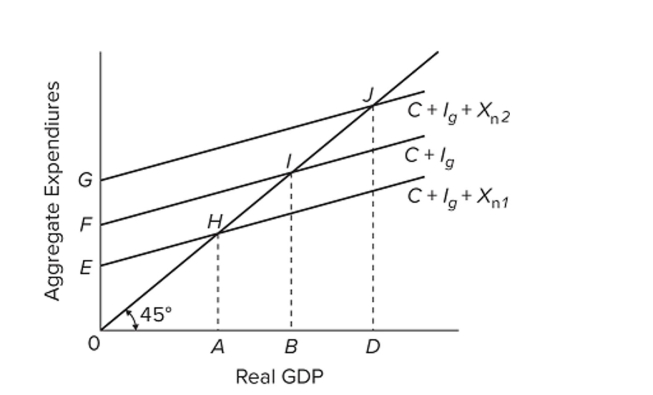 Refer to the diagram. If ( are the net
Exports in the open economy, we can conclude that
Refer to the diagram. If ( are the net
Exports in the open economy, we can conclude that
A) exports are negative.
B) net exports are positive.
C) net exports are negative.
D) trade is balanced.
Correct Answer

verified
Correct Answer
verified
Multiple Choice
Exports have the same effect on the current size of GDP as
A) imports.
B) investment.
C) taxes.
D) saving.
Correct Answer

verified
Correct Answer
verified
Multiple Choice
If aggregate expenditures exceed GDP in a private closed economy,
A) leakages will exceed injections.
B) planned investment will exceed saving.
C) unplanned investment in inventories will occur.
D) saving will exceed planned investment.
Correct Answer

verified
Correct Answer
verified
Multiple Choice
The accompanying schedule contains data for a private closed economy. All ?gures are in billions. If gross investment is $10 at all levels of GDP, the equilibrium GDP will be
A) $300.
B) $260.
C) $220.
D) $180.
Correct Answer

verified
Correct Answer
verified
Multiple Choice
If net exports decline from zero to some negative amount, the aggregate expenditures schedule would
A) shift upward.
B) shift downward.
C) not move. (Net exports do not affect aggregate expenditures.)
D) become steeper.
Correct Answer

verified
Correct Answer
verified
Multiple Choice
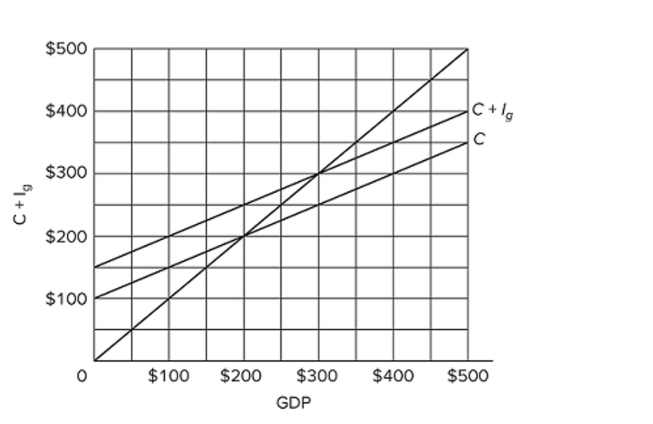 Refer to the diagram for a private closed economy. At the equilibrium level of GDP, investment and saving are both
Refer to the diagram for a private closed economy. At the equilibrium level of GDP, investment and saving are both
A) $50.
B) $100.
C) $20.
D) $40.
Correct Answer

verified
Correct Answer
verified
Multiple Choice
(Advanced analysis) Assume the consumption schedule for a private closed economy is C = 40 + 0.75Y, where C is consumption and Y is gross domestic product. The multiplier for this economy is
A) 3.
B) 4.
C) 5.
D) 10.
Correct Answer

verified
Correct Answer
verified
Multiple Choice
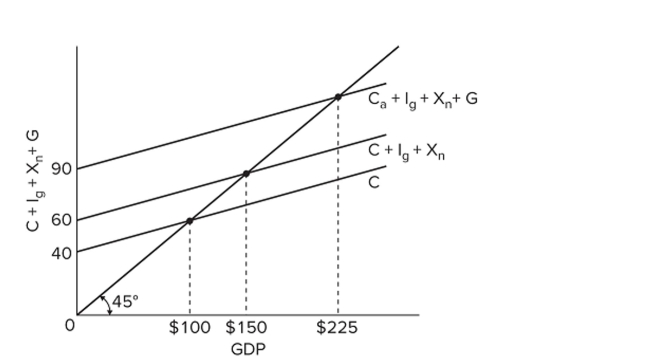 Refer to the diagram. The sizes of the multipliers associated with changes in investment and government spending in this economy are
Refer to the diagram. The sizes of the multipliers associated with changes in investment and government spending in this economy are
A) 2.5 and 1.5, respectively.
B) 3 and 2, respectively.
C) both 2.5.
D) 2 and 3, respectively.
Correct Answer

verified
Correct Answer
verified
Multiple Choice
Refer to the tables of information for a private closed economy. The multiplier for this economy is
A) 2.
B) 2.5.
C) 3.
D) 4.
Correct Answer

verified
Correct Answer
verified
Showing 41 - 60 of 126
Related Exams